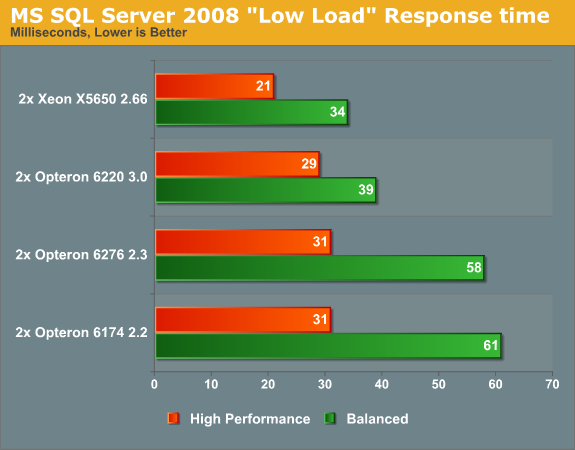The Opteron 6276: a closer look
by Johan De Gelas on February 9, 2012 6:00 AM EST- Posted in
- IT Computing
- CPUs
- Bulldozer
- AMD
- Opteron
- Cloud Computing
- Interlagos
MS SQL Server 2008 R2 at Low Load
Even in this virtualized age, lots and lots of servers are running close to idle quite a bit of time. We also checked how our servers behaved with 40 concurrent users.

The CPUs with the highest single threaded performance have the advantage with the balanced power management mode, but in this situation the power consumed is a lot more important:

The Opteron 6174 has no core gating and it shows: the power consumed is about 10 to 15% higher. The Xeon continues to lead in balanced mode, with clearly better response times and a small power advantage. At low load the Opteron 6220 does well, but the best Opteron remains the Opteron 6276. It offers comparable performance/watt to the Xeon in "High Performance mode" : slightly lower power consumption with slightly higher but still very respectable response times.










46 Comments
View All Comments
Scali - Friday, February 10, 2012 - link
No, because if you read the ENTIRE benchmark configuration page, you'd see that all the AMD systems had 2 CPUs as well.Scali - Saturday, February 11, 2012 - link
Oh, and while we're at it... the Intel system had only 48 GB of 1333 memory, where the AMDs had 64 GB of 1600 memory.(Yes, Bulldozer is THAT bad)
PixyMisa - Saturday, February 11, 2012 - link
Or rather, MySQL scales that poorly.What we can tell from this article is that if you want to run a single instance of MySQL as fast as possible and don't want to get involved with subtle performance tuning options, the Opteron 6276 is not the way to go.
For other workloads, the result can be very different.
JohanAnandtech - Saturday, February 11, 2012 - link
Feel free to send me a suggestion on how to setup another workload. We know how to tune MySQL. So far none of these settings helped. The issue discussed (spinlocks) can not be easily solved.Scali - Saturday, February 11, 2012 - link
I'm not sure if you bothered to read the entire article, because MySQL was not the only database that was tested.There were also various tests with MS SQL, and again, Interlagos failed to impress compared to both Magny Cours-based Opterons and the Xeon system.
JohanAnandtech - Saturday, February 11, 2012 - link
The clockspeed of the RAM has a small impact here. 64 vs 48 GB does not matter.Scali - Saturday, February 11, 2012 - link
Not saying it does... Just pointing out that the AMD system had more impressive specs on paper, yet failed to deliver the performance.JohanAnandtech - Saturday, February 11, 2012 - link
Again, it is not CMT that makes AMD's transistor count explode but the combination of 2x L3 caches and 4x 2M L2-caches. You can argue that AMD made poor choices concerning caches, but again it is not CMT that made the transistor count grow.I am not arguing that AMD's performance/billion transistors is great.
Scali - Saturday, February 11, 2012 - link
I think you are looking at it from the wrong direction.You are trying to compare SMT and CMT, but contrary to what AMD wants to make everyone believe, they are not very similar technologies.
You see, SMT enables two threads to run on one physical core, without adding any kind of execution units, cache or anything. It is little more than some extra logic so that the OoOE buffers can handle two thread contexts at the same time, rather than one.
So the thing with SMT is that it REDUCES the transistorcount required for running two threads. By nearly 100%.
CMT on the other hand does not reduce the transistorcount nearly as much. So if you are merely looking at an 'exposion of transistor count', you are missing the point of what SMT really does.
Other than that, your argument is still flawed. Even an 8-thread Bulldozer has a higher transistor count than the 12-thread Xeon here. It's not just cache. CMT just doesn't pack as many threads per transistor as SMT does... and to make matters worse, CMT also has a negative impact on single-threaded performance (which again, if you are looking at it from the wrong direction, may look like better scaling in threadcount... but effectively, both with low and high threadcounts, the Xeon is the better option... and this is just a midrange Xeon compared to a high-end Interlagos. The Xeon can scale to higher clockspeeds, improving both single-threaded and multithreaded performance for the same transistorcount).
So what your article says is basically this:
CMT, which is nearly the same as having full cores, especially in integer-only tasks such as databases, since you have two actual integer cores, has nearly the same scaling in threadcount as conventional multicore CPUs.
Which has a very high 'duh'-factor, since it pretty much *is* conventional multicore.
It does not reduce transistorcount, nor does it improve performance, so what's the point?
JohanAnandtech - Friday, February 10, 2012 - link
Semantics :-). I can call it a core with CMT, or a module with 2 cores. Both are valid.